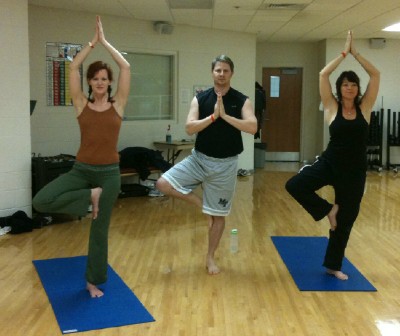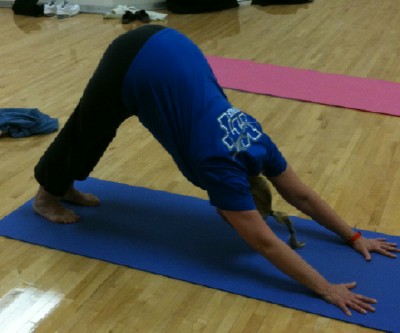And a great way to start this better you (which implies a small improvement, not necessarily a huge leap to perfection) journey might be to try something different–like yoga.
Like many newcomers to yoga, I was familiar primarily with the physical or hatha aspect of yoga–the stretching and bending. I also carried the stereotypical image of the hippie sitting crossed-legged, burning incense and chanting Om . . . Om. If this image popped into your head as well, do read on, because times have changed and the old yogi ain’t what he used to be.
Although true yoga embraces a complete lifestyle, most yoga classes focus on the physical branch and teach flexibility, breathing techniques, relaxation and balance. Personally, I find the ability to comfortably bend down and tie my shoes much more useful than 18 inch biceps and chiseled calves.
For many folks, yoga represents a non-threatening form of exercise. There’s not much jumping and pumping and the classes are welcoming and diverse. “As baby-boomers reach middle-age and beyond, they start wanting to slow down the aging process,” says Johnny Tomanio, Iyengar Yoga instructor at The Club at Westside. “That’s why yoga has grown in popularity recently.”
But yoga isn’t just for the 40ish crowd looking for a new fountain of youth. “Yoga is for everyone. It’s a process that not only teaches physical discipline but also teaches you to live in the present. I’ve taught everyone from amputees to octogenarians, and they’ve all received some sort of benefit from yoga” adds Tomanio.
Luckily, there are several great resources available for trying yoga right here in Murfreesboro and a plethora more in Nashville if you get all excited and want to try Bikrim (hot) or Ashtanga (super strong) yoga.
Where you can get your YOGA on here in the ‘Boro:
Patterson Park Community Center
Beginning/Intermediate Yoga
Monday – 6:30-7:30 pm
Tuesday – 8:30-9:30 am
Wednesday – 6:30-7:30 pm
Sunday – 3-4:30 (with Paul Vaughn)
$4 per class or included with your premium pass
www.murfreesborotn.gov
Sports*Com
Beginning/Intermediate Yoga
Monday – 8-9 am
Tuesday – 6-7 pm
Thursday – 6-7 pm
Saturday – 9-11 (with Paul Vaughn)
$4 per class or included with your premium pass
www.murfreesborotn.gov
Yoga on the Square
Check website for complete class offerings
$15 per class, volume discounts available
$5 Friday Night Yoga 5:45-8:00 pm
www.yogaonthesquare.com
Murfreesboro YMCA
Yoga
Tues/Thurs – 7:30-8:30 pm
Yoga Ball
Thursday- 9:15-10:15 am
www.ymcamidtn.org
MAC
Flow Yoga
Monday – 5:35-6:35 pm
Restorative Yoga
Tues/Thurs – 5:30-6:30 pm
www.murfreesboroathleticclub.com
Just Try It
It‘s a fact that anyone can practice yoga. Every pose has a modification, so no matter your mobility or flexibility there are postures you can perform, and while most people will begin yoga for physical reasons, you can’t escape the serenity that will start popping up. As you begin to walk taller, you’ll notice how much better the view is. As you begin to relax your shoulders, you’ll notice how much lighter your groceries are, and as you begin to breathe deeper you’ll experience a new kind of harmony–the kind that comes from truly being in tune.
Stay flexible
Yoga in a Nutshell (yoga purists please forgive me)
Yoga is a Sanskrit word meaning union. It is not a religion but rather a philosophical school of thought based on the Bhagavad Gita section of the epic Indian poem Mahabharata. In the poem, a great warrior is faced with a harrowing struggle. He is torn between his duty to fight with his brothers for a noble cause and his aversion to slaying the enemy, which includes other relatives and his teachers. The god Krishna accompanies the young warrior on a passage that helps him with this decision. The happenings along this journey allegorically detail the makings of a moral and just life, which is the foundation of Yoga.
Now, what we commonly know as yoga today is based on the ancient Yoga Sutra by Patanjali. It contains 195 statements that serve as the practical basis for most modern yoga. The Sutra also distinguishes the eight limbs of yoga.
1) Yamas – ethical standards (golden rule)
2) Niyama – self-discipline and spiritual observances
3) Asana – poses (what most of us know as Yoga)
4) Pranayama – breathing
5) Pratyahara – sensory withdrawal (focus inward)
6) Dharana – concentration
7) Dhyani – meditation
8 ) Samadhi – enlightenment (liberation)
Within these eight limbs, there are six branches which represent various approaches to life.
1) Raja – meditation
2) Karma – what we experience today is created by our past actions
3) Bhakti – devotion – positively channeling emotions
4) Jnana – wisdom – through the study of scripture and text
5) Hatha – physicality – balance and alignment
6) Tantra – ritual – reverence
There are roughly 11 styles of yoga. The most popular forms grow from the Hatha (physical) limb and include ananda, iyengar, bikram, vinyasa and astanga.
Another side bar
TYPES of YOGA and what to expect
Hatha
Although Hatha is not truly a yoga style, it is often used to describe yoga classes. Hatha classes are usually slow-paced and serve as a good introduction to the basic yoga asanas (poses). All yoga that involves moving the body and assuming asanas is hatha yoga. According to allspiritfitness.com, “Hatha yoga is meant to keep the body a healthy place for the spirit to live,” as is the goal of all physical yoga.
Ananda
The gentlest yoga style, Ananda combines breathing awareness with spoken affirmations and beginning yoga poses. These positive verbal declarations are what distinguish Ananda from other yoga styles. The goal is energy awareness and inner relaxation.
Iyengar
This style focuses on balancing and aligning the body and is the most common style in Middle Tennessee. Students will use straps, blocks, bolsters, blankets and chairs to achieve certain poses. Iyengar yoga is great for beginners because the props compensate for an initial lack of flexibility, the poses are held for longer periods of time and Iyengar-trained instructors pay close attention to detail. You will learn proper asana form in an Iyengar class. The goal is body alignment and symmetry.
Bikram (Hot Yoga)
With the room temperature set between 95 and 105 degrees, Bikram literally melts the toxins away. A standard bikram class last between 75 and 90 minutes and the class revolves around a series of 26 poses intended to cleanse to body from the inside out. The hot environment helps loosen stiff or tight muscles. This one takes some getting use to, but it can be well worth the sweaty beginning.
Vinyasa
Vinyasa focuses on flow. It is distinguished by accompanying music and the continual movements from one pose to the next. It maintains a gentle pace and could be considered the next level after basic poses are mastered. The focus is on breathing and alignment. Vinyasa builds strength and flexibility. Nashville doctor and practicing Vinyasa student Catherine Stallworth says,”Vinyasa, with its flowing style adds an aerobic component to the isometric strengthening provided by the asana. I’m recommending it to my patients with arthritis and back and shoulder pain.”
Astanga (also spelled Ashtanga)
Astanga yoga is both physically and mentally demanding. It is a series of intense sequential poses that flow quickly from one to the next. The Primary Series in Astanga contains backbends, hand stands and serious twists. This is not for the beginner, but it is very inspiring for the beginner. Astanga centers on stamina, strength and breath control. “Astanga feels like an inner massage. I feel clearer. It’s both strengthening and relaxing,” says student Marcelle Guilbeau.
















